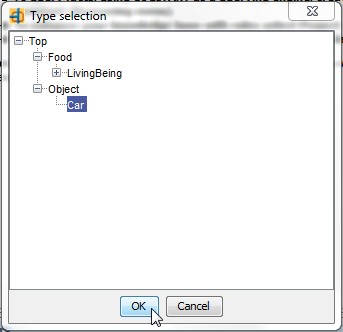Overview
Contextual knowledge consists of graphical tools that facilitate manual building of fact graphs. The graph-based formalism used (derived from Conceptual Graphs), provides graphical representations that users can easily understand, and are furthermore logically founded. These sorts of graph are associated with a type of the vocabulary to represent.to most common knwoledge generally associated with this type. This mechanism provides "ready to use" pieces of graphs to speed up the annotation work. Prototypic graphs are associated with concept and relation type hierarchies and Pattern graphs are associated with nesting types.Prototypical graphs
A prototypical graph is a Simple Concept graph (SG) which can be associated with a concept type or with a relation type. A prototypical graph defines usual contexts of a type.A prototypical graph owns a special node, called the head of the prototypic graph, with the same type as the type from which it is the prototype. A node x of an annotation graph having a type with an associated prototypic graph allows an extension of the annotation by merging the node x with the head of the prototypic+ graph. A concept type or relation type can have several prototypes which represents different ways for describing an entity or a relation. The annotator has only access to prototypes whose all vertices are in the vocabulary of the current module during the annotation process.
 create a new prototypic for concept |
 select the head of the prototypic graph |
 head of the graph associated with prototypic graph |
 complete the graph |
Prototypical graph must be edited to be completed.The graphical editor recognize the head of the graph and paint it with special color and border, this vertex can be a concept or a relation depending on the type associated with the prototypical graph. It cannot be edited or removed, just moved.
At this point we have an operational prototypic graph for the concept type 'Car'.
With this example, It can be renamed "has a legal driver", it can be used on any graph, with any concept typed as a 'Car' or a subtype of 'Car'.

contextual menu proposes to insert a copy of the prototypic graph

the result
 |
Note that the piece of graph added by the use of prototypical graph can be modified, populated with individuals, or removed. Insertion of a prototypical graph just speeds up the annotation work. And this is also true for pattern graph usage. |
Pattern graphs
A pattern graph is a Simple Conceptual Graph (SG) associated with a nesting type. In an annotation context a nesting type is an annotation type. Thus a pattern graph is a template for a kind of annotation. Several pattern graphs can be associated with the same nesting type. A pattern graph represents a starting point when describing a document with respect to the chosen annotation type, i.e. a nesting type N. It gathers general and frequent notions appearing when describing a document with respect to N. A pattern graph has to respect the vocabulary of the module associated with the nesting type. This constraint ensures that the use of a pattern does not break the consistency of the annotation. create a new pattern |
 select the nesting type associated with pattern |

edit a new pattern graph

insert a copy of the pattern graph inside nested graph

the result
 |
Note that the pieces of graphs added by the use of pattern graph can be modified, populated with individuals, or removed. Insertion of a pattern graph just speeds up the annotation work. And this is also true for prototypical graph usage. |